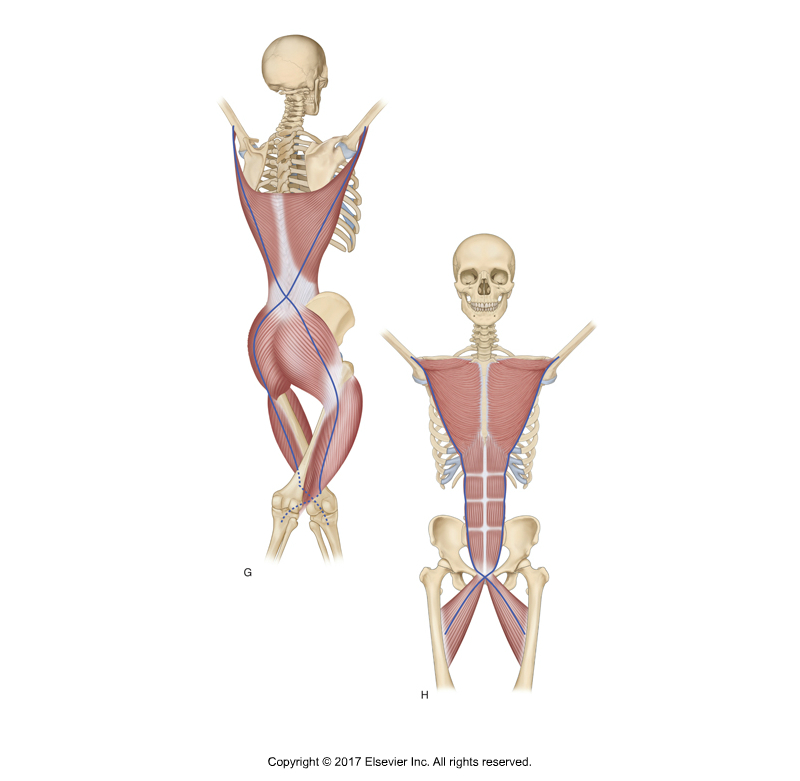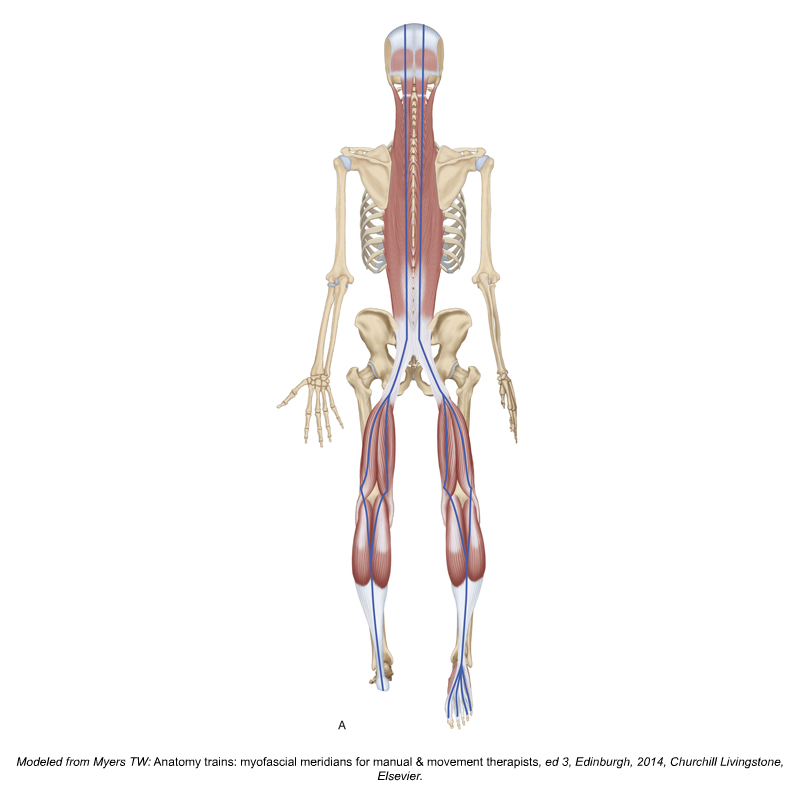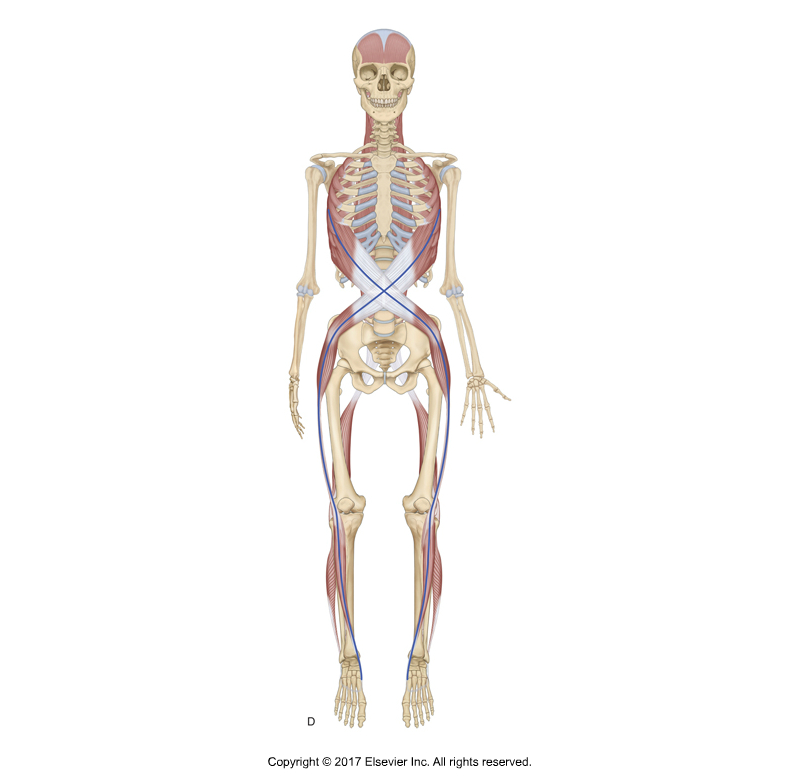The Evidence of Myofascial Meridians
BACK AND FRONT FUNCTIONAL LINE MYOFASCIAL MERIDIANS. PERMISSION JOSEPH E. MUSCOLINO. KINESIOLOGY – THE SKELETAL SYSTEM AND MUSCLE FUNCTION, 3RD ED. (ELSEVIER, 2017).
The Anatomy Trains Myofascial Meridians concept by Tom Myers is popular amongst manual and movement therapists. There are also several similar myofascial continuity or myofascial chain concepts proposed by different authors (e.g. Stecco’s Fascial Manipulation) based on the authors experience and intuition. However there has been little scientific evidence to support this myofascial continuity concept until recently. Jan Wilke and researchers from Goethe University in Frankfurt, Germany searched for the evidence on the existence of six myofascial meridians, as proposed by Tom Myers in 1997. The study was published in the March 2016 issue of Archives of Physical Medicine and Rehabilitation.
The researchers in this meta study (a meta study is a study that reviews a body of previous studies) looked for relevant human anatomical dissection articles published between 1900 and December 2014 in scientific publication databases. The authors appraised peer-reviewed anatomical dissection studies that reported morphological continuity between the muscular components of the myofascial meridians. Also, papers on general anatomy of the corresponding body region were also searched. A continuity between two muscles was only documented if two independent investigators agreed that it was clearly reported. Also, two independent investigators rated methodological quality of included studies. The review identified 6589 articles. Of these, only 62 papers met the inclusion criteria.
Strong Evidence Found
SUPERFICIAL BACK LINE MYOFASCIAL MERIDIAN. PERMISSION JOSEPH E. MUSCOLINO. KINESIOLOGY – THE SKELETAL SYSTEM AND MUSCLE FUNCTION, 3RD ED. (ELSEVIER, 2017).
The review suggests strong evidence for the existence of three myofascial meridians: the Superficial Back Line (all three transitions verified, based on 14 studies), the Back Functional Line (all three transitions verified, eight studies) and the Front Functional Line (both transitions verified, six studies).
Moderate to Strong Evidence Found
SPIRAL LINE MYOFASCIAL MERIDIAN. PERMISSION JOSEPH MUSCOLINO. KINESIOLOGY – THE SKELETAL SYSTEM AND MUSCLE FUNCTION, 3RD ED. (ELSEVIER, 2017).
Moderate to strong evidence is available for parts of the Spiral Line (five of nine verified transitions, 21 studies) and the Lateral Line (two of five verified transitions, ten studies).
For the Spiral Line, continuity between rhomboids and serratus anterior, serratus anterior and external abdominal oblique, and external abdominal oblique and internal abdominal oblique were found. However, no continuity was found below the pelvis.
For the Lateral Line, only continuity iliotibial tract and gluteus maximus/tensor fasciae latae, and gluteus maximus/tensor fasciae latae and abdominal obliques were found.
No Evidence Found
No evidence exists for the Superficial Front Line (no verified transition, seven studies). There is no reported structural connection between the rectus femoris muscle and rectus abdominis. Also, sternalis, which is suggested to be the cranial continuation of rectus abdominis, exists only in a small percentage of the population. Even if present, it does not fuse consistently with the rectus abdominis.
Conclusion
The authors suggested that the practical relevance is twofold. First, the existence of the myofascial meridians might help to explain the phenomenon of referred pain. For example, myofascial trigger points in the calf have been shown to elicit pain that radiates to the sole of the foot and the posterior thigh.
A second aspect relates to therapy and training of the musculoskeletal system. Treatment according to myofascial meridians could be effective in reducing back pain. Several studies have shown that low back pain patients display reduced hamstring flexibility. Overload injuries in competitive sports represent another entity of pathologies, which possibly occur due to the presence of myofascial meridians. Recent studies indicate that tightness of the gastrocnemius and the hamstrings are associated with plantar fasciitis. Groin pain or athletic pubalgia is suggested to be provoked by a tight adductor longus and a weak rectus abdominis. Strain transmission along meridians would both open a new frontier for the understanding of referred pain and provide a rationale for the development of more body-wide holistic treatment approaches.


